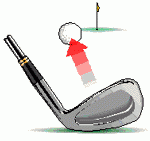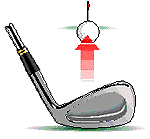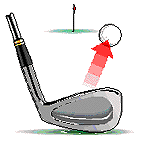One of the most important club head specifications affecting accuracy is the lie angle of irons at impact. You can make a perfect swing with the clubface square to the target line, and the ball will not end up on that line if the lie angle does not sole correctly at impact.
Try this experiment to make this concept more concrete. Take your stance with a short iron in your hands. Then lower the club in your hands, and observe as the club lie becomes more upright (the toe is in the air). Notice what happens to the club as you lower it until the shaft is on the ground. While it is impossible to hit the club in this position would would happen if you could? The ball would start
left by the amount of the club loft, and backspin would be completely replaced by hook spin. That is why you righties out there hit draws with your clubs when the ball is above your feet. The directional angle of the club becomes more upright, and some backspin is replaced with hook spin. The drawings below illustrate this more clearly:
Too upright a lie will cause the ball to start left with a hooking action. Correct lies where the club soles center at impact will start at the target line with no side spin. Flat lies will cause the ball to start right with a slicing action. Longer irons are typically too flat as the downward centrifugal action of the downswing causes these softer shafts to droop down.
Your correct lie angle for each club will be determined with a dynamic lie test where each club’s lie will be bent to its correct position using our tour van Mitchell Golf Bending Machine.



